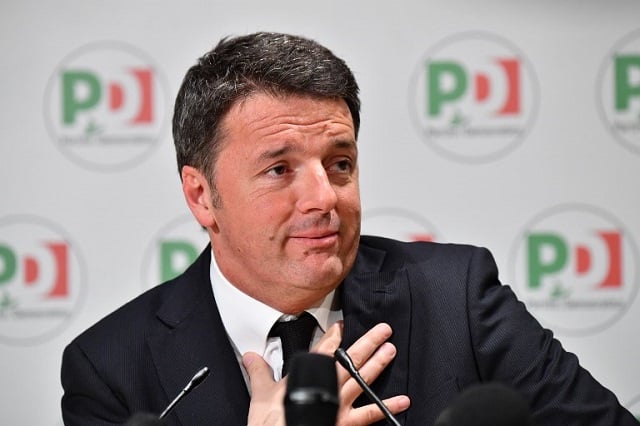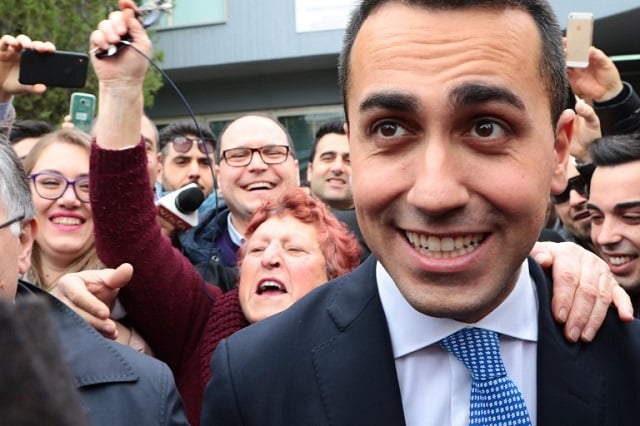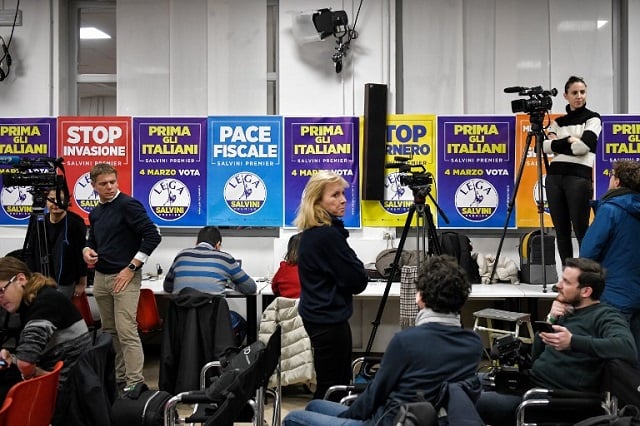Understanding the Italian election result, and what happens now?

Politics professor James Newell looks at the winners and losers of the Italian election, how we got here, and what happens next.
The two great winners from the Italian election are above all the national-populist League (up from 4 percent to 18 percent) and the anti-establishment Five Star Movement (M5S) (up from 25 percent to 32 percent) which garners its support from across the country and from voters located across the political spectrum from left to right.
The losers are the centre-left Democratic Party (PD) (down from 25 percent to 19 percent) and Silvio Berlusconi’s Forza Italia (FI) (down from 22 percent to 14 percent), no longer the dominant force in its coalition thanks to the surge in votes for the League. The new great divide in Italian politics is no longer the one between left and right but the one dividing the mainstream-establishment parties on the one hand and the populists, with over 50 percent, on the other.

PD leader Matteo Renzi hands in his resignation. Photo: Alberto Pizzoli/AFP
How has this come about? Let us start with the centre-left. In government since 2013, the PD sought
to appeal to voters on the basis of its record, which was a creditable one.
It introduced important measures to combat poverty. Last summer it reached an agreement with the government of Libya which has stemmed the flow of refugees and asylum seekers reaching Italy from across the Mediterranean. The Italian economy is reviving. The government has been praised by the OECD and in other quarters for a series of structural reforms deemed essential to raising productivity and
investment.
The problem was that the man who most personified these successes – the PD’s Prime Minister of 18 months, Paolo Gentiloni – was not his party’s leader and therefore the PD suffered from a considerable handicap, in an era of mediatized and personalized politics. Gentiloni was unable to translate his considerable personal popularity -- he was ranked repeatedly as the country's most liked politician -- into support for the PD as a party.
More generally, the PD, like parties of the centre-left elsewhere in Europe, has suffered from the loss of any kind of cultural ascendency since the collapse of the Berlin Wall. It has incorporated the neo-liberal narratives of its adversaries on the right and in so doing failed to offer representation to a working class that now feels threatened by the effects of globalization, especially austerity and mass migration. The left’s natural constituency has been left prey to alternative appeals, and the inevitable consequence has been a dramatic advance for the populist right represented by the League.
The Five Star Movement, meanwhile, has succeeded in winning votes in several quarters. It ran a highly professional campaign in which it successfully portrayed itself as both a party of anti-establishment protest (personified by Alessandro Di Battista who significantly had a front-line role but was not actually a candidate) and as a party of government (personified by its youthful prime ministerial candidate, Luigi di Maio).

Luigi Di Maio poses with supporters after casting his vote. Photo: AFP
In this way it was able to mobilize those driven by the long-standing and deep-seated anti-political sentiments of Italian voters; those driven mainly by disappointment with the outgoing government, and those who might otherwise have been attracted by the new-found moderate profile of an 81-year old Berlusconi who was once an anti- establishment figure but who, having had several turns at the helm, no longer convinces.
What now then? Let us begin with the institutional trajectory. The current government will remain in office until some time after the new Parliament meets for the first time on March 23rd to elect the presidents of the two branches of the legislature, the Chamber of Deputies and the Senate. The outcome of these elections could give some indications, if they have not already emerged from public debate in the run-up, of the governing alliances possible.
Then, the President of the Republic (Sergio Mattarella) will begin consultations with the parties with a view to identifying a governing majority and a person able to lead it. If, and only of, there is reasonable certainty about this, the President will make a formal prime ministerial appointment by giving a PM candidate a full mandate to form a government. Once appointed, the new government will have to overcome the hurdle of confirmatory votes of confidence in both chambers of Parliament. If this can't be achieved, Italy will be left in the hands of a caretaker government.
-
17 memorable quotes from Italy's rollercoaster election campaign
-
What the election result tells us about Italy's north-south divide
-
What next for Italy? A look at the post-election scenarios
What is the composition of the new government – if one emerges – likely to look like?
On the one hand, one might argue that the mainstay of the incoming government will be the Five Star Movement – this on the basis that, as it is the largest party but without a majority, it is too small to govern alone but too strong to be excluded: there is no majority for a ‘mainstream’, FI-PD, coalition, and the parties of the centre right (the League, FI and Brothers of Italy) do not command a majority either.
On the other hand, the parties of the centre right constitute the largest single coalition represented in Parliament and the League’s Matteo Salvini has explicitly ruled out a governing arrangement with the M5S. This is understandable: Salvini will want to inherit Berlusconi's support and thus consolidate his leadership of the centre right. He will not want to waste such an opportunity by playing ‘second fiddle’ to a government led by Di Maio.
Meanwhile, the PD has also ruled out governing with the Five Star Movement, with departing leader Matteo Renzi saying the PD's new role will be in opposition. So the future of the Italian left looks grim indeed – but so too does the future of Italy and of Europe. For the former, there is the prospect that the M5S fails successfully to complete its transition from party of protest to party of government, as it grapples with the difficulties of making decisions that will inevitably have winners and losers, and so ends up fuelling the already high levels of popular disenchantment with Italy’s political class.
For Europe, there is the near certainty of conflict between an incoming government and the Brussels institutions given that both the M5S and the League have built their remarkable successes on growing Euroscepticism. For those Italians who are comfortable with the cultural changes of globalisation, in sympathy with the left’s internationalist themes and now the bedrock of what remains of the left, the outcome of the election will have been a very sad one indeed.
Comments
See Also
The two great winners from the Italian election are above all the national-populist League (up from 4 percent to 18 percent) and the anti-establishment Five Star Movement (M5S) (up from 25 percent to 32 percent) which garners its support from across the country and from voters located across the political spectrum from left to right.
The losers are the centre-left Democratic Party (PD) (down from 25 percent to 19 percent) and Silvio Berlusconi’s Forza Italia (FI) (down from 22 percent to 14 percent), no longer the dominant force in its coalition thanks to the surge in votes for the League. The new great divide in Italian politics is no longer the one between left and right but the one dividing the mainstream-establishment parties on the one hand and the populists, with over 50 percent, on the other.

PD leader Matteo Renzi hands in his resignation. Photo: Alberto Pizzoli/AFP
How has this come about? Let us start with the centre-left. In government since 2013, the PD sought
to appeal to voters on the basis of its record, which was a creditable one.
It introduced important measures to combat poverty. Last summer it reached an agreement with the government of Libya which has stemmed the flow of refugees and asylum seekers reaching Italy from across the Mediterranean. The Italian economy is reviving. The government has been praised by the OECD and in other quarters for a series of structural reforms deemed essential to raising productivity and
investment.
The problem was that the man who most personified these successes – the PD’s Prime Minister of 18 months, Paolo Gentiloni – was not his party’s leader and therefore the PD suffered from a considerable handicap, in an era of mediatized and personalized politics. Gentiloni was unable to translate his considerable personal popularity -- he was ranked repeatedly as the country's most liked politician -- into support for the PD as a party.
More generally, the PD, like parties of the centre-left elsewhere in Europe, has suffered from the loss of any kind of cultural ascendency since the collapse of the Berlin Wall. It has incorporated the neo-liberal narratives of its adversaries on the right and in so doing failed to offer representation to a working class that now feels threatened by the effects of globalization, especially austerity and mass migration. The left’s natural constituency has been left prey to alternative appeals, and the inevitable consequence has been a dramatic advance for the populist right represented by the League.
The Five Star Movement, meanwhile, has succeeded in winning votes in several quarters. It ran a highly professional campaign in which it successfully portrayed itself as both a party of anti-establishment protest (personified by Alessandro Di Battista who significantly had a front-line role but was not actually a candidate) and as a party of government (personified by its youthful prime ministerial candidate, Luigi di Maio).

Luigi Di Maio poses with supporters after casting his vote. Photo: AFP
In this way it was able to mobilize those driven by the long-standing and deep-seated anti-political sentiments of Italian voters; those driven mainly by disappointment with the outgoing government, and those who might otherwise have been attracted by the new-found moderate profile of an 81-year old Berlusconi who was once an anti- establishment figure but who, having had several turns at the helm, no longer convinces.
What now then? Let us begin with the institutional trajectory. The current government will remain in office until some time after the new Parliament meets for the first time on March 23rd to elect the presidents of the two branches of the legislature, the Chamber of Deputies and the Senate. The outcome of these elections could give some indications, if they have not already emerged from public debate in the run-up, of the governing alliances possible.
Then, the President of the Republic (Sergio Mattarella) will begin consultations with the parties with a view to identifying a governing majority and a person able to lead it. If, and only of, there is reasonable certainty about this, the President will make a formal prime ministerial appointment by giving a PM candidate a full mandate to form a government. Once appointed, the new government will have to overcome the hurdle of confirmatory votes of confidence in both chambers of Parliament. If this can't be achieved, Italy will be left in the hands of a caretaker government.
- 17 memorable quotes from Italy's rollercoaster election campaign
- What the election result tells us about Italy's north-south divide
-
What next for Italy? A look at the post-election scenarios
What is the composition of the new government – if one emerges – likely to look like?
On the one hand, one might argue that the mainstay of the incoming government will be the Five Star Movement – this on the basis that, as it is the largest party but without a majority, it is too small to govern alone but too strong to be excluded: there is no majority for a ‘mainstream’, FI-PD, coalition, and the parties of the centre right (the League, FI and Brothers of Italy) do not command a majority either.
On the other hand, the parties of the centre right constitute the largest single coalition represented in Parliament and the League’s Matteo Salvini has explicitly ruled out a governing arrangement with the M5S. This is understandable: Salvini will want to inherit Berlusconi's support and thus consolidate his leadership of the centre right. He will not want to waste such an opportunity by playing ‘second fiddle’ to a government led by Di Maio.
Meanwhile, the PD has also ruled out governing with the Five Star Movement, with departing leader Matteo Renzi saying the PD's new role will be in opposition. So the future of the Italian left looks grim indeed – but so too does the future of Italy and of Europe. For the former, there is the prospect that the M5S fails successfully to complete its transition from party of protest to party of government, as it grapples with the difficulties of making decisions that will inevitably have winners and losers, and so ends up fuelling the already high levels of popular disenchantment with Italy’s political class.
For Europe, there is the near certainty of conflict between an incoming government and the Brussels institutions given that both the M5S and the League have built their remarkable successes on growing Euroscepticism. For those Italians who are comfortable with the cultural changes of globalisation, in sympathy with the left’s internationalist themes and now the bedrock of what remains of the left, the outcome of the election will have been a very sad one indeed.

Join the conversation in our comments section below. Share your own views and experience and if you have a question or suggestion for our journalists then email us at [email protected].
Please keep comments civil, constructive and on topic – and make sure to read our terms of use before getting involved.
Please log in here to leave a comment.